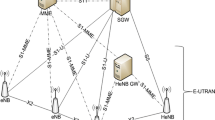Abstract
Mobility management is the most important feature of a wireless cellular communication system. Continuation of an active call is one of the most important quality measurements in the cellular systems. Handover makes it possible for a user to travel between various networks or cells while having a seamless connection. This paper shows that, performance of cellular network can be increased with proposed adaptive soft handoff algorithm, which dynamically calculates the Soft handover margin based on the received signal strength and distance. Performance is evaluated in terms of the performance metrics active set update rate, active set size, soft handover region and probability of outage. Simulation results show that soft handover algorithm gives better performance with adaptive soft handoff margin compared to that of fixed soft handover margin in varied propagation conditions.
Similar content being viewed by others
References
Çeken C., Yarkan S., Arslan H. (2001) Interference aware vertical handoff decision algorithm for quality of service support in wireless heterogeneous networks. Computer Networks 54: 726–740
Corazza, G. E., Giancristofaso, D., & Santucci, F. (1994). Characterization of handover initiation in cellular mobile radio networks. IEEE technology conference (pp. 1869–1872).
EIA/TIA/IS-95A, Mobile station-base station compatibility standard for dual-mode wideband spread spectrum cellular system. Telecommunication Industry Association, Washington CD, May 1995.
Garg V. K., Wilkes J. E. (1998) Principles and applications of GSM (pp. 247–276). Prentice Hall PTR, Upper Saddle River, NJ
Gudmundson M. (1991) Correlation model for shadow fading in mobile radio communication system. Electronics Letters 27: 2145–2146
Homnan, B., Kunsriruksakul, V., & Benjapolakul, W. (2000). A Comparative Evaluation of Soft Hnadoff between S-95A and IS-95B/cdma2000. In Proceedings of IEEE vehicular technology (pp. 34–37).
Laiho-Steffens, J., Jasberg, M., Sipila, K., Wacker, A., & Kangas, A. (1999). Comparison of three diversity handover algorithms by using measured propagation data. In Proceedings of VTC’99 Spring. Houston, TX (pp. 1370–1374) May 1999.
Leu, A. E., & Mark, B. L. (2002). Discrete-time analysis of soft handoff in CDMA cellular networks. In Proceedings of IEEE vehicular technology conference (pp. 3222–3226).
Narrainen R. P., Takawira F. (2001) Performance analysis of soft handoff in CDMA cellular networks. IEEE Transactions on Vehicular Technology 50(6): 1507–1517
Qualcomm Corporation. (1997). Diversity-handover method and performance. ETSI SMG2 Wideband CDMA Concept GroupAlpha Meeting, Stockholm, Sweden, September 1997.
Reig J. (2006) Capacity analysis in downlink WCDMA systems using soft hanodver techniques with SIR-based power control and site selection diversity transmission. IEEE Transactions on Vehicular Technology 55(4): 1362–1372
Singh, N. P., & Singh, B. (2007). Effects of soft handover margin under various radio propagation parameters in CDMA cellular networks. IEEE conference on WCSN-2007 (pp. 47–50).
Singh B. (2007) An improved handover algorithm based on signal strength plus distance for interoperability in mobile cellular networks. Wireless Personal Communication 43: 879–887
Universal mobile telecommunications system (UMTS); Radio resource management strategies (3GPP TR 25.922 version 5.0.0 Release 5).
Vassiliou, V., Antoniu, J., Pitsillides, A., & Hadjipollas, G. (2005). Simulating soft handover and power control for enhanced UMTS. IEEE 16th international symposium on personal, indoor and mobile radio communications (pp. 1646–1651).
Viterbi A. J., Viterbi A. M., Gilhousen K. S., Zehavi E. (1994) Soft handoff extends cell coverage and increases reverse link capacity. IEEE Journal on Selected Areas in Communications 12: 1281–1288
Wang, S. S., Sridsha, S. & Green, M. (2002). Adaptive soft handoff method using mobile location information. Vehicular Technology Conference, 2002, VTC Spring 2002. IEEE 55th (Vol. 4, pp. 1936–1940).
Wang, X., Xie, S., & Hu, X. (2009). Recursive analysis for soft handoff schemes in CDMA cellular systems. IEEE Transaction on Wireless Communications, 8(3), 1499–1507.
Wong D., Lee T. J. (1997) Soft handoffs in CDMA mobile systems. IEEE personal communication 4: 6–17
Yang, X., Ghaheri-Niri, S., & Tafazolli, R. (2000). Performance of power triggered and Ec/N0-triggered soft handover algorithms for UTRA. 3G mobile communication technologies, conference publication, (Vol. 477, pp. 7–10).
Yang, X., Ghaheri-Niri, S., & Tafazolli, R. (2000). Evaluation of soft handover algorithms for UMTS. In 2000 11th IEEE international symposium on, personal, indoor and mobile radio communications (Vol. 2, pp. 772–776).
Zhang N., Holtzman J. M. (1998) Analysis of CDMA soft-handoff algorithm. IEEE Transactions on Vehicular Technology 47(2): 710–714
Zhang, D., Wei, G., & Zhu, J. (2002). Performance of hard and soft handover for CDMA systems. IEEE vehicular technology conference (pp. 1143–1147).
Zhu H., Kwak K.-S. (2007) Performance analysis of an adaptive handoff algorithm based on distance information. ELSEVIER Computer Communications 30: 1278–1288
Author information
Authors and Affiliations
Corresponding author
Rights and permissions
About this article
Cite this article
Singh, N.P., Singh, B. Performance Enhancement of Cellular Network Using Adaptive Soft Handover Algorithm. Wireless Pers Commun 62, 41–53 (2012). https://doi.org/10.1007/s11277-010-0037-1
Published:
Issue Date:
DOI: https://doi.org/10.1007/s11277-010-0037-1




